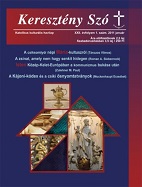Szép, Boldog, Csodatevő. Csíksomlyó és a Mária-Dogmák
Beautiful, happy, wonder-worker. Csíksomlyó and the Marian dogmas
Author(s): Vilmos TánczosSubject(s): Christian Theology and Religion
Published by: VERBUM Keresztény Kulturális Egyesület
Keywords: Marian dogmas; popular/vernacular faith; folk ritual; Hungarian folk tradition; wonder-worker statue
Summary/Abstract: Christianity was accepted by the Hungarians among other European nations. The Christian teaching and ritual mixed with the vernacular ancient culture and belief. Thus even the strange elements blended in one religious worldview that formed the Hungarian folk „version” of Christianity. The acceptance of different ritual and liturgical forms were not equal: some were preferred to others. Some did not impress the imagination of people, others were fully accepted and embraced. This happened to the Marian dogmas of the Catholic Church. The dogma about the virginity of Mary e.g. did not influence the vernacular faith. The feast of the adormition (15 Aug.) is well-embedded in popular religiosity. There are several vernacular cultic elements surrounding it as the simple popular imagination was fascinated by death and defeating death. Many stories depict this event, there are several rituals that show how this specific dogma met the Hungarian folk tradition and became an integral part of it. In this feast the Hungarian people–who could not accept the negativist ascetics of the Middles Ages that did not think much of the body–saw the defeat of death in the body of Mary, mother of Jesus. Thus the human body was triumphant over the sepulchre. In the Marian cult around the shrine of Csíksomlyó/Şumuleu the most influencial dogma was the one concerning the Immaculate Conception (although the dogma was officially announced in 1854). The elements of this cult can be seen in the figure of Mary as shown in the wonderful statue dating back to 1510-1515. It is also a symbol of the mysticalmagic belief of ancient Hungarians. The presence of the statue and its religious influence helped Hungarians of the region Csík/Ciuc preserve their Catholic identity during reformation.
Journal: Keresztény Szó
- Issue Year: XXII/2011
- Issue No: 01
- Page Range: 1-3
- Page Count: 3
- Language: Hungarian

